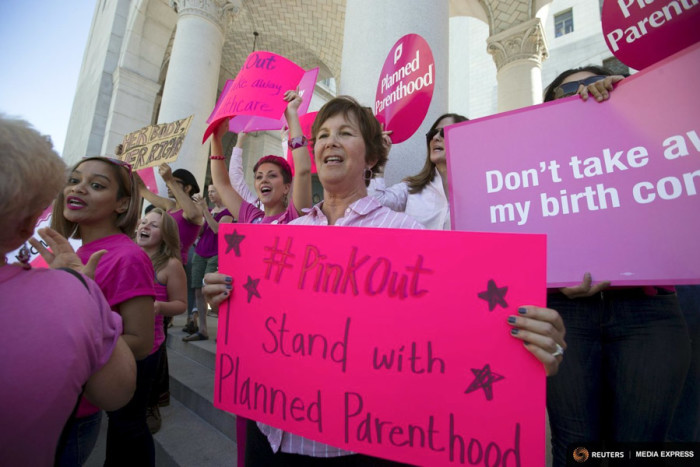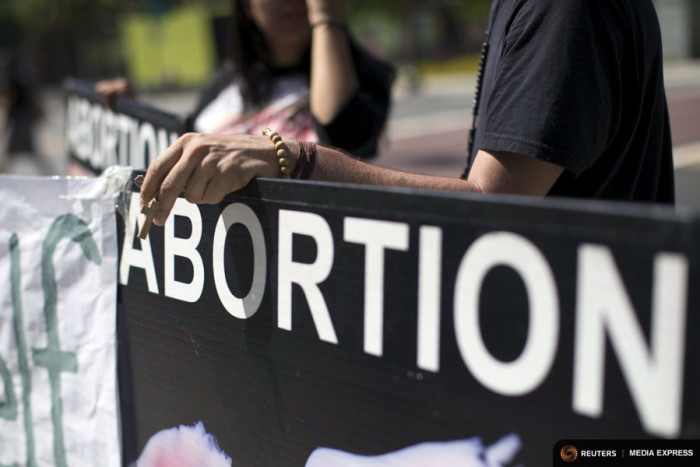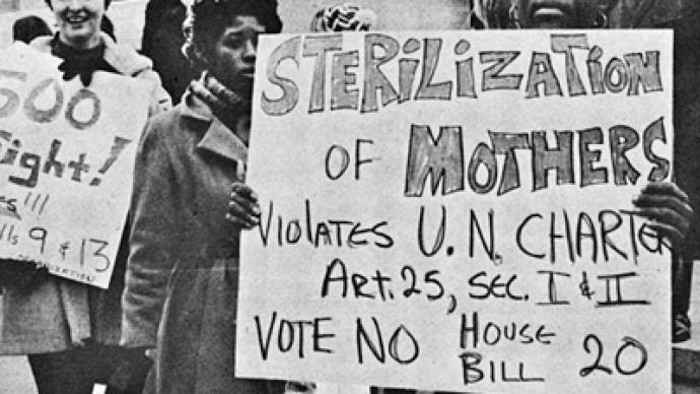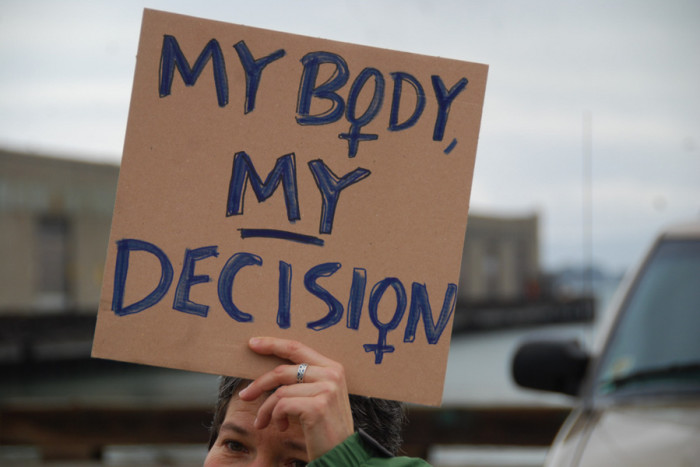
The battle over abortion rights is more heated than it has been in decades. Regular efforts by conservatives in U.S. government to defund Planned Parenthood have been invigorated by undercover (and likely illegal) video showing Planned Parenthood officials discussing medical research on fetal tissue. There has been outrage across conservative America (even though many people who are outraged have not actually watched the videos in question).
In response to the uproar and the efforts by the House of Representatives to defund one of the nation’s largest providers of abortion services, pro-choice women and men across the country have been speaking out. Through internet campaigns, twitter hashtags, in-person protests — women have once again risked ridicule and shame to defend what they view as a fundamental right — the right to complete bodily autonomy.
But as with many feminist movements, the spotlight is once again on white women.
Pull up any article, watch any interview, and you’re likely to see a young, attractive, white face looking back at you. The women visibly representing the movement to protect abortion rights are less likely to be impacted by decreased access than poor, minority women are (not to mention how crucial abortion access can be for transgender men).
This is a dangerous problem, because while women of color are being ignored by many in the mainstream abortion rights movement, they are also being exploited by the anti-abortion movement. Prominent politicians like Ben Carson talk about “black genocide” with Planned Parenthood setting up shops in black neighborhoods to “control the population.” This talk is not new. For decades, anti-abortion activists have tried to manipulate black populations — and take advantage of white liberals’ desire to not seem racist — by implying that abortion rights are part of a vast racist conspiracy.

As a black woman I’ve been subject to these attempts at manipulation and exploitation online through my participation in the #ShoutYourAbortion campaign. Multiple anti-abortion activists (the majority of them white) have accused me of being a pawn of racist conspiracy and unwittingly supporting black genocide.
These rumors of conspiracy find fertile ground because throughout history, this country has repeatedly tried to control the reproduction of women of color.
It’s not just about abortion. Every possible reproductive right for a woman of color has been subject to societal and government oppression:
The Right to Become Pregnant
From the early 1900s through the late 1970s, women of color (as well as some poor women and women with mental disabilities) were sterilized without their informed consent. In the South, such sterilization became known as “Mississippi appendectomies.” Black women were even sterilized unnecessarily in teaching hospitals as practice for medical residents. A 1973 lawsuit by the Southern Poverty Law Center found that 100,000-150,000 women were sterilized each year under federally-funded programs. The U.S. government has admitted to sterilizing 3,406 Native American women without their consent, and North Carolina alone sterilized 7,600 people without consent. In North Carolina, 65 percent of these sterilizations were performed on black women, even though they only made up a quarter of the state’s female population.

This practice wasn’t confined to the South. In California, an estimated 20,000 sterilization operations were performed between 1909-1979, with many Mexican-American women claiming that they were pressured minutes after giving birth to sign away their reproductive rights on forms only available in English. A campaign in Puerto Rico to reduce the poor population left 30 percent of Puerto Rican women sterile by 1965. Interviews with many of these Puerto Rican women showed that they were led to believe that these procedures were reversible, and did not know they were consenting to permanent sterilization.
The Right to Prevent Pregnancy
While many women of color have found their ability to become pregnant taken from them, others have faced socio-economic hurdles in their right to control pregnancy.
Studies have repeatedly shown that minorities have far less access to routine medical care than whites. There are fewer doctors available in minority neighborhoods and economic disparities make travel to doctors outside of minority neighborhoods difficult. Women who do have access to doctors who can prescribe birth control often report discrimination or poor service. Twenty-eight percent of black women have also reported feeling pressured to take a different birth control than they wanted. If you are not comfortable with your doctor, you will be less likely to talk about proper usage and ask questions about side effects, reducing the efficacy of birth control plans.
It is also important to mention that sexual assault does lead to unintended pregnancies and women of color are disproportionately at risk. Studies suggest that approximately 5% of rapes lead to pregnancy, causing an estimated 25,000-32,000 conceptions each year. Black women are 10% more likely to be raped, and Native American women are shockingly twice as likely to be raped as white women.
With these factors combined, it is not surprising that women of color in general have a higher unintended pregnancy rate than white women.

The Right to a Healthy Pregnancy
These disparities in medical access and care have led to an increase in infant mortality rate in black women that is beginning to rival that of some developing nations. A quarter of black women receive late or no prenatal care during their pregnancies, compared to 12% of white women. This lack of access, combined with medical discrimination, lack of access to proper nutrition, and economic instability, have contributed to an infant mortality rate that is more than twice that for white mothers.
The Right to Raise Your Baby
For over 100 years, Native American women have had their children stolen from them through government-sponsored adoption programs. The Indian Adoption Project and its successor the Adoption Resource Exchange of North America removed thousands of Native American children from their homes, with 85% of those children placed with white families, from 1658 through the 1970’s.
These forced adoption practices were thought to be discontinued in the 70’s, but were instead funneled into the foster care system. Reports in 2003 showed Native American children were three times as likely to be placed in foster care as white children. A shocking NPR report in 2011 showed that in South Dakota, 700 Native American children were being taken from their homes each year.
The school-to prison pipeline and the criminalization of brown youth has taken thousands of black and Hispanic children from their mothers as well. Black children are 4.5 times and Latino children are 2.5 times more likely to be arrested than white children for the same crimes. In New York, black and Latino youth make up 80 percent of the state’s juvenile detention residents. Here in King County, youth of color accounted for 73 percent of those in juvenile detention last year.
It’s Bigger Than Planned Parenthood
Planned Parenthood is one of the few reliable providers of birth control, early prenatal services, reproductive health, and abortion services available in communities of color. Their services are vital to the community – but only as one small piece of much-needed reproductive services.

Women of color need the ability to protect their ability to conceive through informed consent for all medical procedures. Women of color need the ability to prevent pregnancy through easy, affordable access to doctors free of bias, and knowledgeable about the cultural differences in the communities they service. Women of color need the ability to raise the children they have, with social services aimed at providing resources to keep families together, instead of tearing them apart, and a cessation of the criminalization of black and Latino youth.
Mostly, women of color need you to listen to them.
We have been spoken for, decided for, lobbed back and forth over abortion debates like a hand grenade. But women of color are capable of interpreting and communicating their own reproductive needs. We know what is needed for reproductive justice, because we are the ones suffering the most from lack of it.
If you care about women’s rights and reproductive health – listen to women of color. If you care about decreasing the number of abortions – listen to women of color. If you care about women of color – listen to women of color.


Why not mention Margaret Sanger in this selective history lesson? Abortion has always been the preemptive extermination of undesirables to purify the demographics of society. It’s always been about population control, not about women’s rights! I would suggest you look at blackgenocide.org that black people were targeted from the beginning.
Have you heard of Dr. Richard Day medical director of planned parenthood and the plan to normalize abortion through redirecting the purpose of sex from procreation to pleasure, making contreception available, using sex education to get kids interested in sex at an earlier age, encouraging homosexuality, diminishing the importance of a family unit to be replaced with loyalty to the state, and eventually guilt tripping parents into allowing children to get abortions? Those are the plans of the initiates, while the goals for the population were focused on rights so they would adopt the agenda not knowing they were supporting their own cultural demise.
I would also suggest listening to ex KGB agent Yuri Bezmenov on the psychological warfare techniques of ideological subversion, and demorilzation work before you continue supporting moral rellitiveness, and your own destruction. You can youtube Yuri Bezmenov. It will be a catalyst and paradigm shift away from being a useful idiot of the establishment.